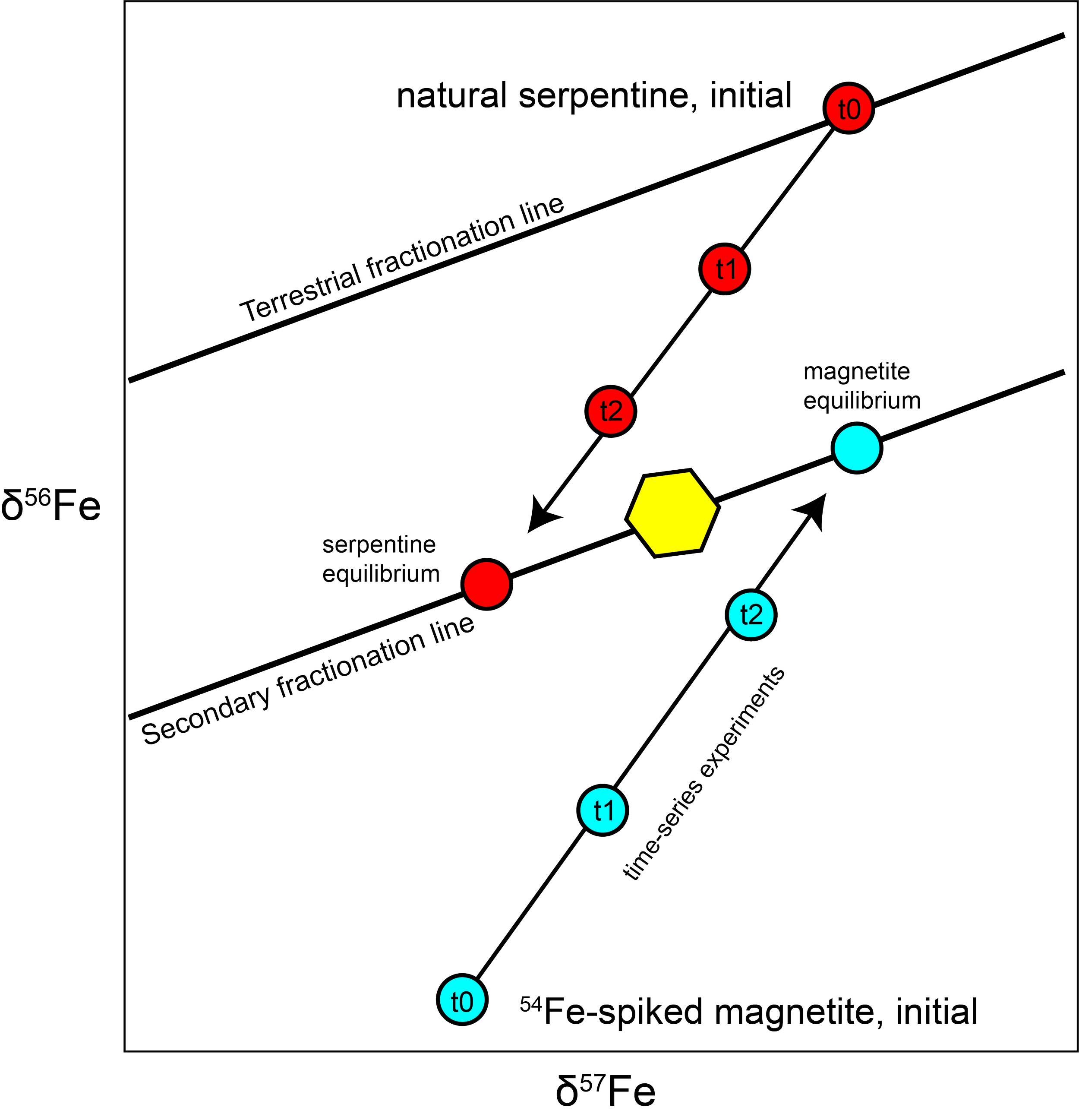
The main goal of my research is to understand the various processes involved in mass transfer and chemical interactions in the oceanic lithosphere, subduction zones, and in deep planetary interiors. These processes include dehydration, melting, interactions between fluids/magmas and surrounding rocks. Specifically, I am focused on studying the role of fluids and magmas containing carbon, hydrogen, and oxygen, and how they interact with the surrounding rocks to transport elements and volatiles between the Earth's surface and its deeper reservoirs. Furthermore, I am interested in studying these interactions through laboratory measurements, particularly in terms of their transport properties like electrical conductivity and the partitioning behavior of elements during such interactions. Fluid-rock interactions along the slab-mantle Interface
Understanding processes at the slab-mantle interface leads to important insights into the formation of metasomatic rocks, which directly influence the rheology of plate interfaces, element mobility and cycling. In my previous studies I showed, by integrating constraints from petrology, geochemistry, and thermodynamic reaction-path models, that chlorite-rich metasomatic rocks can form by diffusional Mg metasomatism between the mafic and ultramafic rocks under prograde metamorphic conditions (Codillo et al. 2022a, G3). I also showed that, contrary to common thought, talc is unlikely to form in large abundance in ultramafic rocks metasomatized by Si-rich slab-derived fluids (Codillo et al., 2022b, GRL). These results have significant implications for the processes that generate large megathrust earthquakes and slow slip events at the plate interface.
My current work on this topic combines high-pressure experiments and thermodynamic calculations to investigate the serpentinization of the forearc mantle wedge by slab-derived fluids.
Geochemical consequences of mélange melting
Mélange rocks display a wide range of elemental and isotopic signatures reflecting distinct input lithologies and fluids, but have different phase equilibria from any subducted oceanic basalt and sediment inputs. I experimentally investigated the melting phase equilibria and density evolution of mélange rocks using a piston cylinder device at P-T conditions relevant to subduction zones. In Codillo et al. (2023; EPSL), I showed that melting of mélanges is unlikely to occur along the slab-top at pressures ≤ 2.5 GPa and that diapirism into the hot mantle wedge is required for melting. I also experimentally investigated the fate of buoyant mélange diapirs and their interaction with the overlying mantle using high P-T experiments and microanalytical techniques. I showed that interactions between mélange and mantle peridotites can produce melts that display compositional characteristics similar to natural arc magmas (Codillo et al., 2018, Nature Communications). Additionally, I examined the compositions of global arc magmas and presented new interpretations on the evolution of slab-to-mantle transfer mechanisms from subduction initiation to arc maturity. The results help to reconcile the long-standing debate on the relative importance of competing end-member models for how arc magmas are formed in global subduction zones (Codillo and Le Roux, submitted).
My current work aims to determine the trace-element compositions of experimentally produced low-degree melts of natural mélange rocks to evaluate the causes of trace-element fractionation that are observed in arc magmas and continental crust.
Experimental stable isotope fractionations at high P-T conditions
The chemical and isotopic compositions of terrestrial and planetary materials can reveal a wealth of information about the processes and conditions of their formation and evolution. For example, a large fraction of primitive arc magmas display isotopically light iron (Fe) isotope compositions relative to the peridotitic mantle source and mid-ocean ridge basalt (MORB). Our understanding of the mechanisms that govern isotope fractionation observed in primitive arc magmas, however, is severely hindered by the lack of laboratory experiments conducted at relevant high P-T conditions. At Carnegie, I use a novel application of the three-isotope technique to piston-cylinder experiments at high P-T conditions to investigate the equilibrium isotopic fractionation between serpentine and magnetite, minerals that are abundant at the slab-mantle interface. This experimental approach holds promise for establishing equilibrium fractionation factors for silicate and oxide minerals stable in planetary interiors at experimental timescales that are achievable in laboratory settings.
Electrical properties of hydrous and carbonated Earth materials
Electrical conductivity is a transport property that is largely sensitive to variations in temperature, porosity, and chemistry (including volatile contents). In the field, electromagnetic methods have revealed significant electrical conductivity variations in subduction zones that are thought to be related to slab dehydration and melting. However, accurate interpretation of the observed conductivity anomalies requires comprehensive electrical conductivity data of different Earth materials determined in the laboratory. At Carnegie, I conduct laboratory experiments using impedance spectroscopy in a multi-anvil press to determine the in situ electrical conductivity of a variety of hydrous and carbonated minerals and rocks at high P-T conditions. My results on carbonated peridotite and carbonated eclogite at 8–15 GPa, reveal for the first time the in situ electrical response at the onset of carbonatite melt formation at depths up to 450 km (Codillo et al., under review). This work provides important new constraints on the nature of the electrical structure of the asthenospheric mantle and fluid and melt cycling at its depth.
Volatiles in planetary interiors
A magnetic field is a crucial factor in the emergence and persistence of life on a planetary surface, which in turn is controlled by its core dynamo. Understanding core dynamo and magnetic field generation requires understanding of the core volatile composition. However, the volatile contents of core materials at core pressures remains poorly constrained, primarily because of experimental and analytical challenges. Using iron meteorites as natural analogues for core materials of small planetary bodies, I measure the concentrations of volatiles (H, C, Si, N, S) on a variety of iron meteorites using a NanoSIMS. This research approach will likely add new and crucial constraints on the volatile budget and partitioning behavior of volatile elements in core materials, that would complement and validate existing experimental studies.
Experimental and analytical tools
Multi-anvil press with in situ and real-time impedance spectrometer (Anne Pommier's lab)Piston-cylinder press (Anne Pommier's lab)Multi-Collector Inductively Coupled Plasma Mass Spectrometer (EPL, Carnegie Science)








